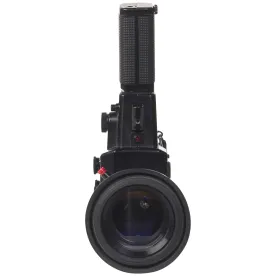Recently, a law firm asked me how to increase their presence in the local community, (of course, I’ll explain some of those in later articles) so I explained the power behind video testimonials. It’s simple, easy, and a bang for your buck. Whether you want to call it social proof, mob mentality, or even crowd psychology, it’s a different approach than one tooting their own horn.
Naturally, people gravitate towards individuals, places, and things that resemble themselves, which is an idea that’s actually called implicit egotism, but that’s another story. It’s vital to understand that when creating a video testimonial, it’s imperative you tap into your target consumers’ desire by showing a similar audience that expresses similar needs and desires.
Testimonial Content
Structure your video so that it has an introduction, main content and an exit. While the filming will last at least from 15 to 30 minutes, your mission is to edit the footage to create a powerful, succinct 45 to 90 seconds of video. It seems short, but the attention span of your average viewer these days is a scant eight seconds. It’s up to you with your story-telling prowess to hold your viewer’s attention for the entire video.
When preparing the testimonial, decide on the message, and think about the most frequent questions that current clients and prospects ask. Then formulate your message from there. You don’t have to showcase an obscure issue even if you did knock it out of the ballpark. Rather, you want your message to interest and engage as many viewers as possible.
But who will be the star of the film? I’m sure the line is out the door but don’t just choose anyone who is willing. Make sure they have a compelling story and that they know how to tell the story. Make sure the story is relevant, digestible, and that the information is concise and believable.
Give the interviewee a list of the questions a few days ahead of filming so that they can prepare thoughtful, yet unscripted, answers. Be sure to let your interviewee know that you are not expecting a written, learned and rehearsed script. It’s important to capture candid footage of someone who can articulate and convey their message.
Next figure out the location. Maybe you want it at a park, walking down the street, inside in a coffee shop, or maybe in a nursery. Whether it’s here or there, choose wisely. You will have more control over environmental sound and lighting if you shoot indoors. However, you need as much equipment if you film outdoors. More on this later.
During the shoot, make your interviewee as comfortable and relaxed as possible. Start out with basic chitchat and conversational questions. Ask the interviewee to tell you about him or herself. Make sure you are filming at this point so your interviewee will become comfortable with the camera on and targeted. We want to reduce this potentially nerve-racking experience.
When you sense that he or she is calm, begin asking your prepared and shared open-ended questions. Don’t ask simple yes or no questions. Above all, actively listen to what he or she is saying. You’ll be able to ask follow-up questions to draw out the story and shape your message. Truly listening will also engage your interviewee, encouraging him or her to share more.
To engage your listeners, it’s a good idea to include emotions. How did your interviewee feel when she or he was faced with the initial problem? Was your interviewee overwhelmed, frightened, worried, confused? How did he or she feel after first talking over the problem with you? Most especially, how did it feel when you successfully solved the issue? Showing these kinds of feelings make a significant impact on the viewer. While you don’t want your interviewee prostrate with grief, you do want to bring the viewer into the story by showing human elements.
Equipment
You have a few options. The first is to hire a production company. That would certainly take the uncertainty out of the actual making of the video.
Or you can dive in and learn what you need regarding video production equipment and how to make the most of the equipment. Producing your own videos could save you money and also allow for video production on your own schedule.
You don’t need to spend thousands of dollars on equipment. In fact, you can use a smartphone to good effect. If you go this route, be sure to use a tripod. You don’t want camera shake on your video. Not only is it amateurish, but it is also literally nausea-inducing. You certainly don’t want to make your viewers ill.
You obviously have the option of purchasing a video camera, but it’s not necessarily needed, better, or even as functional as using a phone or say a DSLR with good video recording capabilities. With that, there is a learning curve you’ll have to overcome, but not anything monumental.
Personally, a DSLR is my fan favorite. One advantage is that you’ll be able to change lenses quite easily, which gives you a wide range of creative options and you have more than one purpose for it.
Audio is extremely important. A viewer may tolerate video that isn’t quite top-notch, but no one will tolerate poor audio. A bad picture can be a stylistic choice, but bad sound is always just bad sound. You need to invest in a dedicated audio recorder and a microphone. Consider a shotgun or lavaliers microphone.
Lighting is the third component of a basic set up. Make sure that wherever you shoot, you have relatively strong and fairly even light. You can shoot outdoors in the shade or indoors in a well-lit room.
For indoor shooting, you might try a three-point lighting system. Put your strongest light (key light) to one side of your subject, another light (fill light) to the other side of your subject and third a light (hair light) pointing to the back of your subject. This will give you a nicely lit scene to shoot.
There are a number of other equipment purchases you could make, but these items will get you started on a solid foundation.
Practice before you record a real interview. Find a willing person to act as a mock interviewee and commence operations. This will give you a comfortable outlook when you shoot your first real interview. It will also give you a heads up on issues that hadn’t occurred to you (like requiring an extension cord or a power strip) so that you can resolve them before you shoot the real video. You don’t want to be bumbling around in front of your star clients. It’s not very awe-inspiring nor does it boost your interviewee’s confidence in how well the impending shoot is going to go.
Editing
You’re going to need video editing software to finish producing your testimonial. You can use the software that comes with your computer, Movie Maker or iMovie, depending on your OS. Or you could go with something more versatile such as Final Cut Pro or Adobe Premiere Pro. To learn how to use the software make YouTube videos your best friend. There really is no better way to learn.
A Few Shooting Tips
Awesome Video Makers has a few great shooting tips:
- When they finish talking press stop. Recording just one question at a time will help in the editing process, making it easier to sort through your footage.
- When your subject goofs up (and they will!), don’t worry. Just stop recording and then start with the question you’re on again. This is another good reason for recording one question at a time.
- Remember, there are no mistakes. All glitches will be edited out.
Conclusion
You’re all set to embark on a challenging yet fun journey that will bring in a much larger client base. Producing an ongoing series of videos will continue to help your law practice grow, increase your SEO, and build trust and confidence in your practice by putting a human face to it.




 />i
/>i

